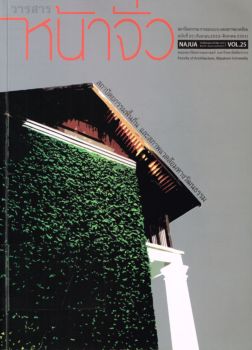ปัจจัยในการตั้งถิ่นฐาน และพลวัติของสถาปัตยกรรม พื้นถิ่นเรือนแพชุมชนพหุวัฒนธรรม: ชุมชนแพสะพานรันตี ต.ไล่โว่ อ.สังขละบุรี จ.กาญจนบุรี
Keywords:
พหุวัฒนธรรม, ความมั่นคงในที่อยู่อาศัย, เรือนแพ, การตั้งถิ่นฐาน, ความแปรเปลี่ยนของสถาปัตยกรรมพื้นถิ่น, Cultural pluralism, stability in dwelling house, raft house, settlement, change of vernacular architectureAbstract
การวิจัยเรื่อง “ปัจจัยในการตั้งถิ่นฐาน และพลวัติของสถาปัตยกรรม พื้นถิ่นเรือนแพชุมชนพหุวัฒนธรรม: ชุมชนแพสะพานรันตี ต.ไล่โว่ อ.สังขละบุรี จ.กาญจนบุรี” มุ่งศึกษาในประเด็นเรื่อง ปัจจัยที่ส่งผลต่อการตั้งถิ่นฐาน ลักษณะทางสถาปัตยกรรม และความเปลี่ยนแปลงลักษณะของสถาปัตยกรรมพื้นถิ่นซึ่งมีลักษณะเป็นเรือนแพ ในลักษณะชุมชนแบบ “พหุวัฒนธรรม (Cultural pluralism)” อันประกอบไปด้วยกลุ่มชาวไทยอีสาน มอญ ลาว2 กะเหรี่ยง และพม่า ซึ่งมีทั้งลักษณะร่วมและต่างทางวัฒนธรรม
จากการศึกษาข้อมูลทางประวัติศาสตร์ผนวกกับการลงพื้นที่สำรวจภาคสนามพบว่า ในประเด็นเรื่องปัจจัยที่ส่งผลต่อการตั้งถิ่นฐานของชุมชนชาวแพนั้นเกิดขึ้นจากแรงขับดันจากถิ่นฐานเดิม อีกทั้งยังมีแรงจูงใจในการอพยพมาตั้งถิ่นฐานในพื้นที่ใหม่ คือ กลุ่มคนไทยอีสานอพยพเนื่องด้วยการแสวงหาแหล่งทำประมงที่อุดมสมบูรณ์ ส่วนกลุ่มที่มีกำเนิดอยู่ในพม่าอพยพมาเนื่องด้วยระบบการปกครองของพม่าที่ไม่ให้ความสำคัญกับชนกลุ่มน้อย ส่วนลักษณะทางสถาปัตยกรรมพื้นถิ่นของเรือนแพ พบว่าเป็นสถาปัตยกรรมที่มีความสอดรับกับสภาพแวดล้อม วิถีชีวิต ศาสนา และความเชื่อของคนในชุมชน แต่เมื่อมีปัจจัยภายนอกอันประกอบด้วย ความเปลี่ยนแปลงของสิ่งแวดล้อมทางธรรมชาติและอิทธิพลของเขื่อนวชิราลงกรณ การถือสัญชาติ และการเข้ามาของวัสดุสมัยใหม่ เข้ามากระทำต่อชุมชน จึงส่งผลให้ลักษณะทางสถาปัตยกรรมของเรือนแพมีความเปลี่ยนแปลง
Factors in Settling Down and Dynamic of Vernacular Architecture in the Form of Raft House in Multicultural Raft Community: A Case Study of Runtee Bridge, Tambon Laiwo, Sangkhlaburi District, Kanchanaburi Province
Natcha Sakul-ngam
Master Degree Student in Vernacular Architecture Program, Silpakorn University
The purposes of this research were to study the factors of the settlement, architectural features and change in vernacular architecture in the form of raft house, under the cultural pluralism of the residents: Thai E-san group, Mon, Laotian, Karen people and Burmese. There are both similar and diff erent points of culture among them.
According to historical information and surveys, it was found that 1) the factors in setting down of people living in raft houses are pressure from their former home town and motivation for immigrating: Thai E-San group searches for the new abundant source for fi shing while Burmese emigrants are discontented with the policy on ignoring the minority by Burmese government 2) vernacular architecture in the form of raft house matches surroundings, lifestyle, religion and belief of villagers. However, external factors like change of the environment, Vajiralongkorn Dam, diffi culties of being alien and modern materials, make changes to the features of this vernacular architecture.





